Fix the dings. Examine all the surfaces, then carefully repair and sand any cracks, holes, or dents before you apply any paint.
Painting Interior Walls
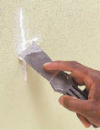
Step One
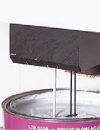
Step Two
Tint the primer. Most primers don’t require tinting, but if you’re changing the finish colour of a room, or using deep, saturated colours , then tinting the primer can help achieve better colour consistency and coverage for your finish coat. Follow the paint manufacturer’s recommendations or ask a salesperson if it will help to tint the primer when you’re getting your paint mixed.
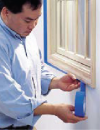
Step Three
Mask the room. Determine the order for painting the room. Paint last the areas that are likely to get dripped on. Prime (and paint) the ceiling first, walls second, and trim last. If you plan to prime the trim with a different tint than you will use on the walls, mask the trim first. Mask the top of the walls if you are painting the ceiling; mask the ceiling and trim you’re starting with the walls.
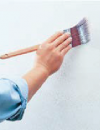
Step Four
Spot prime. If using latex, dip the brush in water to help it absorb the primer. If using alkyd, dip the brush in mineral spirits. Brush out the liquid on a piece of cardboard to remove loose bristles. Brush primer on areas of walls and trim that need special attention: patches in drywall and plaster, areas of bare wood exposed by scraping and sanding, and any spots treated with stain blocker.
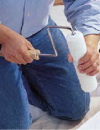
Step Five
Prime the roller. Its hard for a dry roller to absorb primer or paint, so “prime” the roller before you put it in the primer or paint. If the primer is latex, spritz the roller with a garden mister and squeeze off the excess water. Use mineral spirits for alkyd primer. Run the roller over the paint grid or roller pan several times to get an even amount of primer on the roller cover.
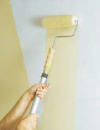
Step Six
Prime the ceiling. Start on the short side of the room and “cut in” the edges about 2 inches wide and about 5 feet long along the edge of the ceiling. Then, wearing safety goggles and an old cap, roll paint onto the ceiling, working the roller into the cut in area to remove as many brush marks as possible. Roll with diagonal strokes and move from the edge toward the middle of the room. Continue cutting in and rolling until you’re finished.

Step Seven
Cut in a section of wall. Wait until the ceiling dries and mask it off with blue painter’s masking tape. Mask off the trim if you haven’t already done so. Starting in a corner, prime along about 5 feet of trim, 5 feet of ceiling, and from top to bottom of the corner.
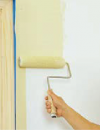
Step Eight
Prime the walls. To minimize the wall area that will have a brushstroke texture, run the roller over the strips you’ve primed during the cutting stage, getting as close as possible to the masked trim, ceiling, or adjacent wall.

Step Nine
Begin rolling at the top section of the wall along the cut in strip. Work to the bottom in a series of Ws, as shown here, to avoid creating a visible pattern of vertical passes. Move along the wall in 3 to 5 foot sections, cutting in and rolling until the job is done. Work in sections small enough to cover with a single load of the roller, and always roll up on the first stroke. The key is to overlap areas of wet paint.
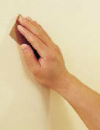
Step Ten
Sand the walls if necessary. Wait until the primer is thoroughly dry and sand lightly with 120 grit sandpaper. Tear a piece of sandpaper in fourths, and then fold one of the quarters in thirds. Whisk the paper along the wall, removing bumps and other high spots. When the paper loads with paint dust, refold it to reveal a fresh face, and continue. Once you’ve finished, wipe the wall with a damp rag to remove dust and debris.
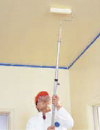
Step Eleven
Roll the ceiling with the finish colour. When the primer is dry, mask around the ceiling. After cutting in a section, start rolling. Protect your eyes with safety goggles and wear an old cap-. A 5 gallon bucket with a roller grid requires filling less often and is less likely to tip than a paint tray. Use a relatively dry roller to reduce spattering. Roll diagonally, as you did to prime, to avoid creating visible rows across the ceiling. Extension poles allow you to reach more area without leaning dangerously from a ladder.
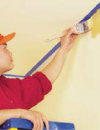
Step Twelve
Cut in the walls. After you’ve painted the ceiling, remove the tape from the top of the walls and allow the ceiling to dry thoroughly. Then mask off the ceiling and trim to paint the walls. Start painting in a corner and cut in a few feet along the ceiling, a few feet along the baseboard, and the starting corner.
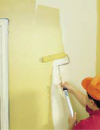
Step Thirteen
Roll close to the wall perimeter. The texture of brushed areas is different from rolled areas. Paint into the freshly cut in areas with a roller, removing as much of the brush stroke texture as possible. Cover as much of the cut in – – as you can without getting paint on other surfaces. Starting with an up stroke, work from the ceiling toward the baseboard, rolling on large strokes. Back roll with a light load of paint to smooth things out.
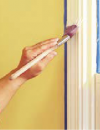
Step Fourteen
Prime and paint the trim. Remove the masking from the walls, allow the paint to dry thoroughly, and mask off for the trim. Control dripping by pouring the trim paint into a small bucket and dip the brush about halfway into the paint. Tap the brush against the sides (instead of scraping it around the rim) to remove excess paint in the tip of the brush; this will leave paint in the body of the brush.
Area's We Commonly Service
Dalkeith, Cottesloe, City Beach, Nedlands, Swanbourne, Mosman Park, Applecross, Claremont, Floreat, Mount Claremont, Crawley, Shenton Park, Subiaco, Mosman Park, Perth CBD, South Perth, North Perth, East Perth, West Perth and Booragoon.










